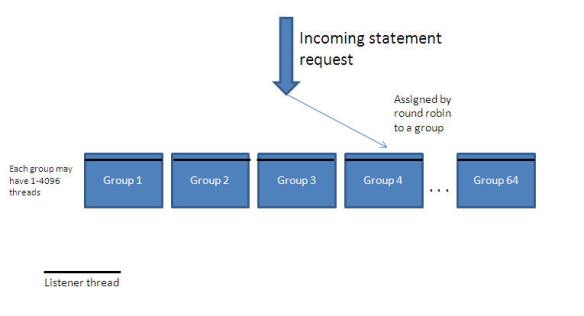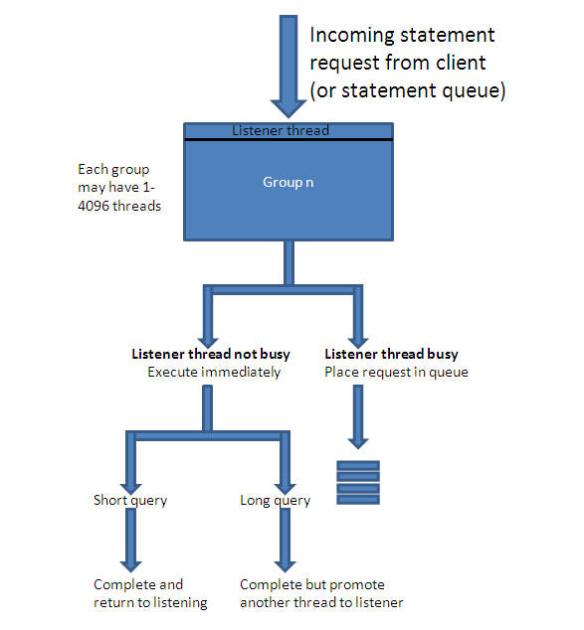By now you have probably heard about the MySQL thread pool plugin and API, but you may not have fully processed the details. Here’s the quick summary: With the new thread pool plugin, there is now an alternative way to handle connection threads in MySQL Enterprise Edition. With the plugin, MySQL connection threads are shared like an extraordinarily well managed timeshare in Hawaii. When one connection is “idle”, asking nothing of and expecting nothing from the database, another connection can use that same thread for its database requests. Threads are released by each connection as soon as the request is completed and go back into the pool for re-use – just like the theoretical timeshare is up for grabs on the weeks you are not there.
In the older, and still default connection thread model, threads are dedicated to a single client for the life of the connection and there are as many threads as there are clients currently connected to the database. This has some disadvantages when the server workload must scale to handle large numbers of connections, and the overhead can be signficant. This occurs for several reasons:
- Lots of threads use lots of memory and can make the CPU cache ineffective
- Too many active threads trying to execute in parallel may cause a high level of resource contention and be inappropriate for the amount of parallelism available
The new thread pool plugin offers an alternative thread pool implementation, and focuses on limiting the number of concurrent, short running statements to mazimize performance and reduce overhead. By limiting the number of concurrent, short running statements and sharing threads, we can control the number of active threads at any one time. Thread management has been revamped and by managing these threads in a highly efficient manner, we end up reducing overhead and maintaining performance levels as the number of users increase.
Here are the mechanics: In the new plugin, threads are organized into groups (16 by default but configurable up to 64 on server startup). Each group starts with one thread and can increase to a maximum of 4096 threads. Additional threads are created only when necessary. Each incoming connection request is assigned to a group by round robin. Each group has one listener thread that listens for incoming statement requests.
 When a statement request comes in, it is executed immediately by the group’s listener thread if it is not busy and there are no other statement requests waiting. If the statement request finishes quickly, the listener thread then efficiently returns to listening and is available to execute the next incoming request, preventing the need for a new thread to be created. If the request does not finish quickly, it runs to completion but another thread is created as the new listener.
When a statement request comes in, it is executed immediately by the group’s listener thread if it is not busy and there are no other statement requests waiting. If the statement request finishes quickly, the listener thread then efficiently returns to listening and is available to execute the next incoming request, preventing the need for a new thread to be created. If the request does not finish quickly, it runs to completion but another thread is created as the new listener.
If the listener thread is busy, the request is queued. There will be a very brief time (configurable with the thread_pool_stall_limit system variable which defaults to 60 ms) while we wait to see if the currently executing statement will finish quickly or not. If it finishes quickly (under thread_pool_stall_limit), we can re-use this thread for the next request in the queue, eliminating the overhead of creating a new thread or having too many short statement trying to execute in parallel .
 You can see how this thread pool design strives to have one thread executing per group at any time . The number of groups (thread_pool_size_variable) is very important, because it approximates the number of short running statements that will be executing concurrently at any one time. Long running statements are prevented from causing other statements to wait, since if they go beyond the thread_pool_stall_limit, another thread will be started and the next request in the queue will execute on it.
You can see how this thread pool design strives to have one thread executing per group at any time . The number of groups (thread_pool_size_variable) is very important, because it approximates the number of short running statements that will be executing concurrently at any one time. Long running statements are prevented from causing other statements to wait, since if they go beyond the thread_pool_stall_limit, another thread will be started and the next request in the queue will execute on it.
Your predominant storage engine will help determine the number of groups you should have. For InnoDB, between 16 and 36 groups seems to work well in many cases, but for MyISAM set it much lower (4-8).
There are two queues for waiting statements, low and high priority. The low priority queue contains:
- all statements for non-transactional storage engines
- all statements if autocommit is enabled
- the first statement in an InnoDB transaction
These statements do not languish in the low priority queue forever since they will get kicked over to the high priority queue when the thread_pool_kickup_timer times them out. However, there is a maximum number of statements that can be moved per time period to keep things under control.
The high priority queue contains
- any subsequent statements in InnoDB transactions, and
- any statements kicked up from the low priority queue.
You can find the thread pool plugin and other commercial extensions in MySQL 5.5.16 and above, available on http://support.oracle.com and the Oracle Software Delivery Cloud https://edelivery.oracle.com . This release contains a plugin library object file which must be placed in the appropriate directory. The server must then be started with the –plugin-load option. Documentation and complete install directions for the plugin can be found at http://dev.mysql.com/doc/refman/5.5/en/thread-pool-plugin.html. There is also a thread pool API available in the Community Edition.
Happy swimming!
Lynn Ferrante has worked with databases in the enterprise for her whole career at MySQL, Oracle, Sybase, and Ingres. She also worked on an open source project called GenMapp (University of California, San Francisco), and contributed to the development of many database applications in the fields of energy and environment